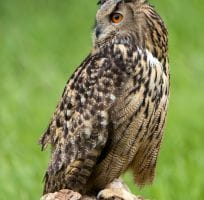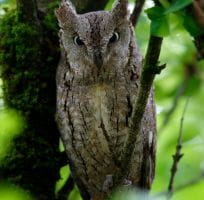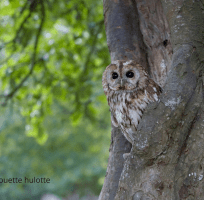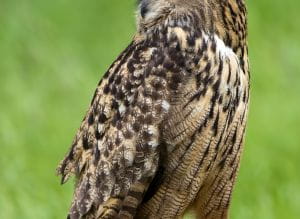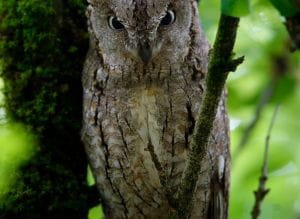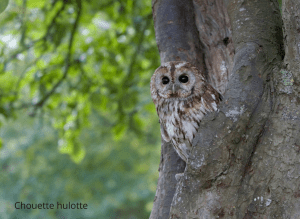The Great Horned Owl
Bubo bubo
The Great Horned Owl is sedentary and lives alone or in pairs.
It is the world’s largest nocturnal bird of prey, with one particularity: the female is heavier (2 to 4 kg) than the male (1.8 to 2.8 kg) and its average wingspan of 170 cm exceeds that of the male by 10 cm!
Its “ou-ho” song is used to mark out its territory after hunting and during the breeding season at the end of winter.
Pairs form in autumn and don’t last a lifetime! Courtship takes place in February/March, and the male’s courtship is quite original: well positioned on the ground, he raises his neck feathers and moves around his partner.
The female lays 2 to 3 eggs, which she incubates alone for 35 days. The chicks leave the nest at around 4 weeks (ground nest), later for nests built on walls (10 weeks)
The Grand-duc’s diet is highly varied. The Great horned owl is an opportunist, capable of hunting corvids, pigeons, small mammals (rats and voles), hares and roe deer fawns. It often takes advantage of the weakness of its prey (illness, wounds) and will even consume carrion.
A formidable predator, it uses a variety of hunting techniques: lying in wait, flying low or along cliffs, and even on foot to catch lizards, frogs and insects!
The scops owl
Otus scops
Much smaller than “its cousin,” the Scops-Owl (males and females are virtually identical) weighs only about a hundred grams with a wingspan of about 50 cm.
It has attractive bark-colored plumage tending towards gray. Its wings are also gray with white flecks.
This little owl, regularly observed on La Réserve, is a trans-Saharan migrant species, arriving in France in late March-early April and leaving again in late summer. It frequents warm, dry environments and occupies a wide range of habitats, from the countryside to the city. But with a preference for open landscapes!
With its rather solitary habits, the Screech-Owl is easily repaired by its melodious song described as “fluttery”, which it emits from dusk onwards after landing on a high point.
Outside the breeding season, this species is rather sociable. It becomes territorial when nesting begins in April.
The female lays between 3 and 5 eggs in a tree or wall cavity. She incubates them alone for 3 to 4 weeks. The chicks are fed by both parents until the end of their second month. Then they try their hand at hunting, with varying degrees of success.
The scops owl feeds mainly on invertebrates, especially large insects (grasshoppers, crickets, cicadas, moths, locusts, beetles). S’it hunts mainly by stalking, on sparsely vegetated ground, it is nonetheless capable of capturing prey in flight or resting on foliage or twigs.
The Tawny Owl
Strix aluco
This medium-sized owl: 40 cm long with a wingspan of one meter and a weight of between 400 and 600 gr. This handsome bird can be clad in gray or bright red plumage, marked with brown and white spots enabling it to blend in with the bark of trees.
The tawny owl is a sedentary, forest-dwelling species. Some individuals are nocturnal, while others are strictly so.
The male’s territorial hoot is the best-known song of all owl species. It is easily imitated by humans and is said to have been used by the Chouans as a rallying cry.
Pairs form in late autumn, and eggs are laid in late winter, most often in a cavity in a tree or rock face.
The female incubates 3 to 5 eggs on her own. During this time (4 weeks) and for 2 weeks after hatching, the male provides food for the whole family. The young leave the nest when they are 5 weeks old, but don’t become independent until they are 3 months old.
Whet owls have a highly diversified diet: invertebrates, frogs, bats, small birds and small terrestrial mammals in particular voles, field mice and shrews. It is an opportunistic predator that prefers to hunt in open woodland, although it has been described in cities.
